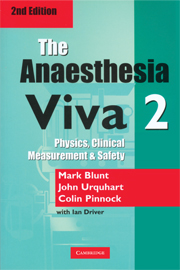Book contents
- Frontmatter
- Foreword to the First Edition
- Preface to the Second Editions
- Contents
- Physics, Clinical Measurement & Safety
- Clinical Anaesthesia
- Example 1
- Example 2
- 6 Example 3
- 7 Example 4
- Example 5
- Example 6
- Example 7
- Example 8
- Example 9
- Example 10
- Example 11
- Example 12
- Example 13
- Example 14
- Appendix 1
- Appendix 2
- Index
Example 2
Published online by Cambridge University Press: 05 February 2015
- Frontmatter
- Foreword to the First Edition
- Preface to the Second Editions
- Contents
- Physics, Clinical Measurement & Safety
- Clinical Anaesthesia
- Example 1
- Example 2
- 6 Example 3
- 7 Example 4
- Example 5
- Example 6
- Example 7
- Example 8
- Example 9
- Example 10
- Example 11
- Example 12
- Example 13
- Example 14
- Appendix 1
- Appendix 2
- Index
Summary
Scenario
A woman of 36 presents for a laparoscopic cholecystectomy. She weighs 140 kg and has a BMI of 36. There are no other features of relevance in the history.
The patient obviously fits the definition of morbid obesity and the questioning will revolve around the definition of Body Mass Index (weight in kg divided by height in metres – squared) and the attendant problems of anaesthesia in this group of patients.
Obesity is increasing in the surgical population, and occurs in the female whose fat comprises more than 30% of her body weight, and in men when more than 25% of the body weight is fat.
Ideal body weight can be calculated by subtracting 100 (men) or 105 (women) from the height in cm.
For example: height 178: ideal weight = 178 − 100 = 78 kg
There are a number of ways of estimating obesity. The commonest is the Quetelet (BMI) index:
Body mass index (BMI)
<20 = underweight
20 − 25 = normal
25 − 30 = overweight
30 − 35 = obese
>35 = morbidly obese
For example:
Height 1.782 = 3.17
Weight = 77 kg
BMI = 77 / 3.17 = 24 − in the normal range.
For example:
Height 1.502 = 2.25
Weight = 95 kg
BMI = 95 / 2.25 = 42 − morbid obesity.
Problems of anaesthesia should be organised by systems.
- Type
- Chapter
- Information
- The Anaesthesia Viva , pp. 86 - 88Publisher: Cambridge University PressPrint publication year: 2003

